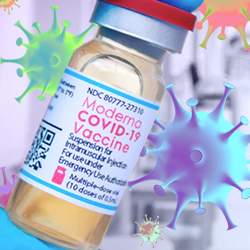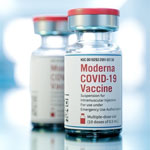By IDSE News Staff
Moderna announced its messenger RNA (mRNA) vaccine booster candidate was effective against the omicron variant of SARS-CoV-2.

The omicron variant is now the primary circulating variant and has been detected in every state, according to the CDC. The BA.2 lineages and sublineages now comprise 87% of circulating virus in the United States, according to the CDC (https://covid.cdc.gov/covid-data-tracker/#variant-proportions).
The omicron-containing bivalent COVID-19 booster candidate, mRNA-1273.214, contains mRNA-1273 (Spikevax) and a vaccine candidate that targets the omicron variant.
The 50 mcg dose of mRNA-1273.214 met all primary end points in a phase 2/3 trial, including neutralizing antibody response against omicron compared with a 50-mcg booster dose of mRNA-1273 in participants who were seronegative at baseline. Prespecified criteria for superiority as measured by neutralizing geometric mean titer ratio (GMR) with the lower bound of the confidence interval greater than 1 was met. The GMR and corresponding 97.5% confidence interval was 1.75 (1.49-2.04). A booster dose of mRNA-1273.214 increased neutralizing geometric mean titer (GMT) against omicron approximately eightfold above baseline levels. Primary end points of noninferiority against ancestral SARS-CoV-2 also were met, with GMR against ancestral SARS-CoV-2 (D614G) of 1.22 (1.08-1.37).
Among seronegative participants one month after administration, the neutralizing GMT against ancestral SARS-CoV-2 for mRNA-1273.214 was 5977 (95% CI, 5322-6713), compared with GMT for mRNA-1273 of 5649 (95% CI, 5057-6311). The GMT against omicron for mRNA-1273.214 was 2372 (95% CI, 2071-2718), compared with GMT for mRNA-1273 of 1473 (95% CI, 1271-1708).
Binding antibody titers (MSD [Meso Scale Discovery]) were also significantly higher (nominal alpha of 0.05) against all other variants of concern (alpha, beta, gamma, delta, omicron) for mRNA-1273.214 compared with mRNA-1273.
The mRNA-1273.214 booster dose was well tolerated in the 437 study participants. The safety and reactogenicity profile of mRNA-1273.214 was similar to that of mRNA-1273 when these vaccines were administered as a second booster dose.
“Looking at these data alongside the durability we saw with our first bivalent booster candidate, mRNA-1273.211, we anticipate more durable protection against variants of concern with mRNA-1273.214, making it our lead candidate for a fall 2022 booster. We are submitting our preliminary data and analysis to regulators with the hope that the omicron-containing bivalent booster will be available in the late summer. Taken together, our bivalent booster candidates demonstrate the power of Moderna’s mRNA platform to develop vaccines that meet immediate, global public health threats,” said Stéphane Bancel, the CEO of Moderna.
In February 2021, Moderna announced its strategy to update booster candidates to address the ongoing evolution of the SARS-CoV-2 virus, including monovalent and bivalent candidates targeting multiple variants of concern. The company’s primary focus has been on the bivalent booster approach, which involves boosters that address two viral strains simultaneously.
Moderna is planning to submit the interim analysis and data to regulators for review in the coming weeks.




